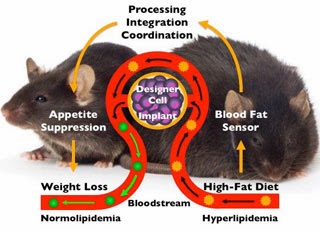Genetic regulatory circuit monitors blood fat
The research group headed by ETH-Zurich professor Martin
Fussenegger from the Department of Biosystems Science and Engineering in
Basel has now developed an early warning system and treatment: an
implantable genetic circuit mainly composed of human gene components. On
the one hand, it constantly monitors the circulating fat levels in the
blood. On the other hand, it has a feedback function and forms a
messenger substance in response to excessively high blood-fat levels
that conveys a sense of satiety to the body.
In order to construct this highly complex regulatory
circuit, the biotechnologists skilfully combined different genes that
produce particular proteins and reaction steps. They implanted the
construct in human cells, which they then inserted into tiny capsules.
The researchers studied obese mice that had been fed fatty
food. After the capsules with the gene regulatory circuit had been
implanted in the animals and intervened due to the excessive levels, the
obese mice stopped eating and their bodyweight dropped noticeably as a
result. As the blood-fat levels also returned to normal, the regulatory
circuit stopped producing the satiety signal.
“Instead of placing the mice on a diet to achieve weight
loss, we kept giving the animals as much high-calorie food as they could
eat,” stresses Fussenegger. The animals ate less because the implant
signalised a feeling of satiety to them. Mice that received normal
animal feed with a five-per-cent fat content did not lose any weight or
reduce their intake of food, says the biotechnologist.
Sensor for different dietary fats
One major advantage of the new synthetic regulatory circuit
is the fact that it is not only able to measure one sort of fat, but
rather several saturated and unsaturated animal and vegetable fats that
are ingested with food at once. However, this development cannot simply
be transferred to humans. It will take many years to develop a suitable
product. Nonetheless, Fussenegger can certainly envisage that one day
obese people with a body mass index of way over thirty could have such a
gene network implanted to help them lose weight. Fussenegger sees the
development as a possible alternative to surgical interventions such as
liposuction or gastric bands. “The advantage of our implant would be
that it can be used without such invasive interventions.” Another merit:
instead of intervening in the progression of a disease that is
difficult to regulate, it has a preventive effect and exploits the
natural human satiety mechanism.
This gene network is one of the most complex that
Fussenegger and his team have constructed to date and was made possible
thanks to the biotechnologist’s years of experience in the field. It is
not the first time he and his team have succeeded in constructing such a
complex feedback regulatory circuit: a number of years ago, they
produced an implant that can also be used to combat gout via a feedback
regulatory circuit.

No comments:
Post a Comment